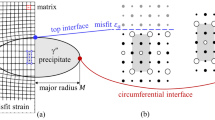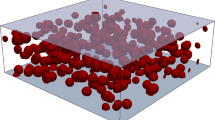Abstract
The physical basis behind the Ostwald ripening process for two-phase mixture has been reviewed in detail, using the various theories developed to describe this process. The Ostwald ripening, also termed second phase coarsening, is generally thought to be slow, diffusion-controlled process which occurs subsequent to phase separation under extremely small under-saturation levels. The major advance for the description of this process was made when Lifshitz, Slyozov and Wagner (also known as the LSW theory) published their papers more than fourty years ago. This classical LSW theory predicts that the ripening kinetics and the particle size distribution function are applicable to dilute systems only [i.e. when the volume fraction (Q) of second phase approaces zero: Q → 0], in which particle-particle interactions are not important. After the publication of the LSW theory, many experimentalists tested the veracity of the theory. Experimentalists have confirmed the prediction of self-similar ripening behavior at long times. However, virtually none of the reported distributions are of the form predicted by the LSW theory. The reported distributions are generally broader and more symmetric than the LSW predictions. It was later realized that a major problem with the LSW approach was the mean field nature of the kinetic equation. In order to remove the zero volume fraction assumption of the LSW theory, the many theories have been developed based on the statistically averaged diffusion interaction of a particle of given size class with its surroundings, using both analytic and numerical methods. Many attempts to determine the statistically averaged growth rate of a particle either do not account for the long-range nature of the diffusional field surrounding the particle, and/or employed ad hoc assumptions in an attempt to account for the diffusional interactions between particles. The strength of the diffusional interactions between particles stems from the long range Coulombic nature of the diffusion field surrounding a particle. As a result, particle interactions occur at distances of many particle diameters and restrict the validity of LSW theory to the unrealistic limit of zero volume fraction of coarsening phase. More realistic models of the ripening process at finite-volume fractions (Q) of coarsening phase have been proposed by various workers such as Brailsford-Wynblatt (1979), Voorhees-Glicksman (1983), Marqusee-Rose (1984), Tokuyama-Kawasaki (1984), Enomoto-Tokuyama-Kawasaki (ETK) (1986), and Yao-Elder-Guo-Grant (YEGG) (1993) models. Although a great deal of progress has been made in understanding Ostwald ripening, a fully satisfactory approach has not yet been found, and it has remained a vexing problem in the field. At present, it is very difficult to determine which of these theories best describes coarsening at finite volume fraction. The statistical mechanical theories, developed to describe systems in which Q ≪ 1, employed the same microscopic equation to describe the coarsening rates of individual particles, but different techniques to perform the statistical averaging. In addition, these theories can be distinguished on yet a finer scale. All of the theories predict that the rate constant will vary as Q 1/2 in this low volume fraction limit. These theories predict that the scaled time-independent particle radius distributions become broader and more symmetric than those predicted by LSW as the volume fraction increases. Clearly more experimental and theoretical work is necessary in order to settle the subtle disagreement now existing between the various Ostwald ripening theories.
Similar content being viewed by others
References
W. OSTWALD, Z. Phys. Chem. 37 (1901) 385.
Idem., “Analytisch Chemie,” 3rd ed. (Engelmann, Leipzig, 1901).
G. W. GREENWOOD, Acta Met. 4 (1956) 243.
R. ASIMOV, ibid. 11 (1962) 72.
I. M. LIFSHITZ and V. V. SLYOZOV, J. Phys. Chem. Solids 19 (1961) 35.
Idem., Sov. Phys.: Solid State 1 (1960) 1285.
C. WAGNER, Z. Electrochem. 65 (1961) 581.
A. J. ARDELL, Acta Met. 20 (1972) 61.
A. D. BRAILSFORD and P. WYNBLATT, ibid. 27 (1979) 489.
C. K. L. DAVIES, P. NASH and R. N. STEVENS, ibid. 28 (1980) 179.
K. TSUMARAYA and Y. MIYATA, ibid. 31 (1983) 437.
J. A. MARQUSEE and J. ROSE, J. Chem. Phys. 80 (1984) 536.
P. W. VOORHEES and M. E. GLICKSMAN, Acta Met. 32 (1984) 2001.
Idem., ibid. 32 (1984) 2013.
J. H. YAO, K. R. ELDER, H. GUO and M. GRANT, Phys. Review B 47 (1993) 14100.
M. MARDER, Phys. Review A 36 (1987) 858.
Y. ENOMOTO, M. TOKUYAMA and K. KAWASAKI, Acta Met. 34 (1986) 2119.
M. TOKUYAMA and K. KAWASAKI, Physica A 123 (1984) 386.
P. W. VOORHEES, Annu. Rev. Mater. Sci. 22 (1992) 197.
S. CORIELL and R. L. PARKER, J. Appl. Phys. 36 (1965) 632.
J. W. GIBBS, 1906, “The Collected Works of J. W. Gibbs” (Longmans, Green and Co, Dover, New York).
M. HILLERT, “Lectures on the Theory of Phase Transformations” (New York, 1975).
P. W. VOORHEES, Ph.D. Thesis, Rensselaer Polytechnique Institue, 1982.
P. W. VOORHEES and M. E. GLICKSMAN, Metall. Trans. A 15A (1984) 1081.
J. J. WEINand J. W. CAHN, “Sintering and Related Phenomena” (Plenum Press, London, 1973) p. 151.
P. W. VOORHEES, J. Statistical Physics 38 (1985) 231.
R. D. VENGRENOVITCH, Acta Met. 30 (1982) 1079.
P. K. RASTOGI and A. J. ARDELL, Acta Met. 19 (1971) 321.
D. H. JACK and R. W. K. HONEYCOMBE, Acta Met. 20 (1972) 787.
A. J. ARDELL and R. B. NICHOLSON, J. Phys. Chem. Solids 27 (1966) 1793.
M. CHATURVEDI and D. W. CHUNG, J. Inst. Metals 101 (1973) 253.
D. J. CHELLMAN and A. J. ARDELL, Acta Met. 22 (1974) 577.
Y. SENO, Y. TOMOKIYO, K. OKI and T. EZUCHI, Trans. Japan Inst. Metals 24 (1983) 491.
T. HIRATA and D. H. KIRKWOOD, Acta Met. 25 (1977) 1425.
S. C. HARDY and P. W. VOORHEES, Metall. Trans. A 19 (1988) 2713.
A. J. ARDELL, “The Mechanism of Phase Transformations in Crystalline Solids” (Institute of Metals, London, 1969) p. 111.
M. HILLERT, “Lectures on the Theory of Phase Transformations” (Am. Inst. Min. Pet. Metall. Eng, New York, 1975).
N. BOWER and J. A. WHITEMAN, “The Mechanism of Phase Transformations in Crystalline Solids” (Inst. of Metals, London, 1969) p. 119.
P. WIRTZ and M. E. FINE, J. Amer. Ceramic Soc. 51 (1968) 402.
T. HIRATA and D. H. KIRKWOOD, Acta Met. 25 (1977) 1425.
C. H. KANGand D. N. YON, Met. Trans. A 12A (1981) 65.
Y. MASUDA and R. WATANABE, in “Sintering Processes,” Materials Science Research, Vol. 13, edited by G. C. Kuczynski (Plenum, New York, 1979) p. 3.
M. TOKUYAMA, K. KAWASAKI and Y. ENOMOTO, Physica 134A (1986) 323.
K. KAWASAKI, Y. ENOMOTO and M. TOKUYAMA, ibid. 135A (1986) 426.
C. W. BEENEKKER, Phys. Rev. A 33 (1986) 4482.
A. J. ARDELL, Phys. Rev. B 41 (1990) 2554.
B. U. FELDERHOF and J. M. DEUTCH, J. Chem. Phys. 64 (1976) 4551.
M. MUTHUKUMAR and R. I. CUKIER, J. Stat. Mech. 26 (1981) 453.
M. BIXON and R. ZWANZIG, J. Chem. Phys. 75 (1981) 2359.
T. R. KIRKPATRICK, ibid. 76 (1982) 4255.
M. TOKUYAMA and R. I. CUKIER, ibid. 76 (1982) 6202.
J. A. MARQUSEE and J. ROSS, ibid. 79 (1983) 373.
H. WENDT and P. HANSEN, Acta Met. 31 (1983) 1649.
M. E. GLICKSMAN and P. VOORHEES, “Phase Transformations in Solids” (edited by Tsakalakos) p. 451.
J. D. GUNTON, M. SAN MIGUEL and P. S. SAHNI, in “Phase Transformations and Critical Phenomena,” Vol. 8, edited by C. Domb and J. L. Lebowitz (Academic, London, 1983).
M. MARDER, Phys. Rev. Lett. 55 (1985) 2953.
J. H. YAO, K. R. ELDER, H. GUO and M. GRANT, Phys. Rev. B 45 (1992) 8173.
Y. ENOMOTO, M. TOKUYAMA and K. KAWASAKI, Acta Met. 35 (1987) 907.
S. P. MARSH, Ph.D. thesis, 1991, Rensselaer Polytechniques Institute.
Idem., In “Simulation and Theory of Evolving Microstructures,” edited by M. P. Anderson and A. D. Rollet (Warrendale, Penn. Min. Mater. Soc.) p. 167.
W. C. JOHNSON, T. A. ABINANDANAN and P. W. VOORHEES, Acta Metall. 38 (1990) 1349.
C. W. J. BEENAKKER, Phys. Rev. A 33 (1986) 4482.
A. D. BRAILSFORD,J. Nuc. Mater. 60 (1976) 257.
D. F. CALET and J. M. DEUTCH, Ann. Rev. Phys. Chem. 34 (1983) 394.
P. P. EWALD, Ann. Phys. (Leipzig) 64 (1921) 253.
A. J. ARDELL, Scripta Met. 24 (1990) 343.
S. C. HARDY, N. AKAIWA and P. W. VOORHEES, Acta Met. 39 (1991) 2931.
K. MAHALINGAM, B. P. GU and G. L. LIEDL, ibid. 35 (1987) 483.
A. N. NIEMI and T. H. COURTNEY, Acta Met. 3 (1981) 1393.
C. H. KANG and D. N. YOON, Metall. Trans. A 12 (1981) 65.
H. CALDERON and M. E. FINE, Mater. Sci. And Eng. 63 (1984) 197.
N. BOWER and J. A. WHITEMAN, “The Mechanism of Phase Transformations in Crystalline Solids” (Inst. of Metals, London, 1969) p. 119.
Author information
Authors and Affiliations
Rights and permissions
About this article
Cite this article
Baldan, A. Review Progress in Ostwald ripening theories and their applications to nickel-base superalloys Part I: Ostwald ripening theories . Journal of Materials Science 37, 2171–2202 (2002). https://doi.org/10.1023/A:1015388912729
Issue Date:
DOI: https://doi.org/10.1023/A:1015388912729




